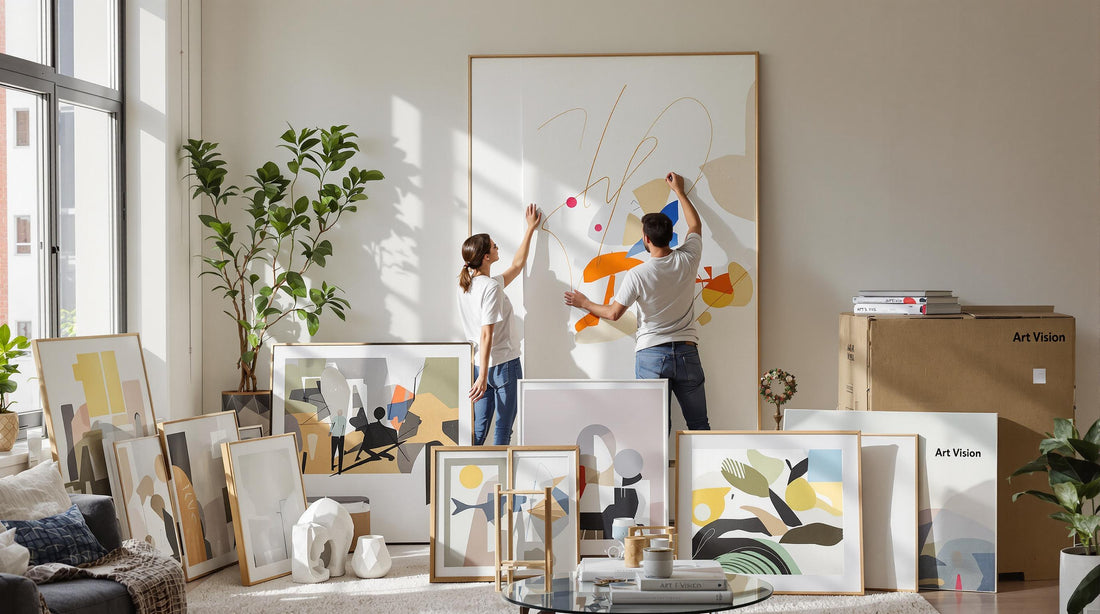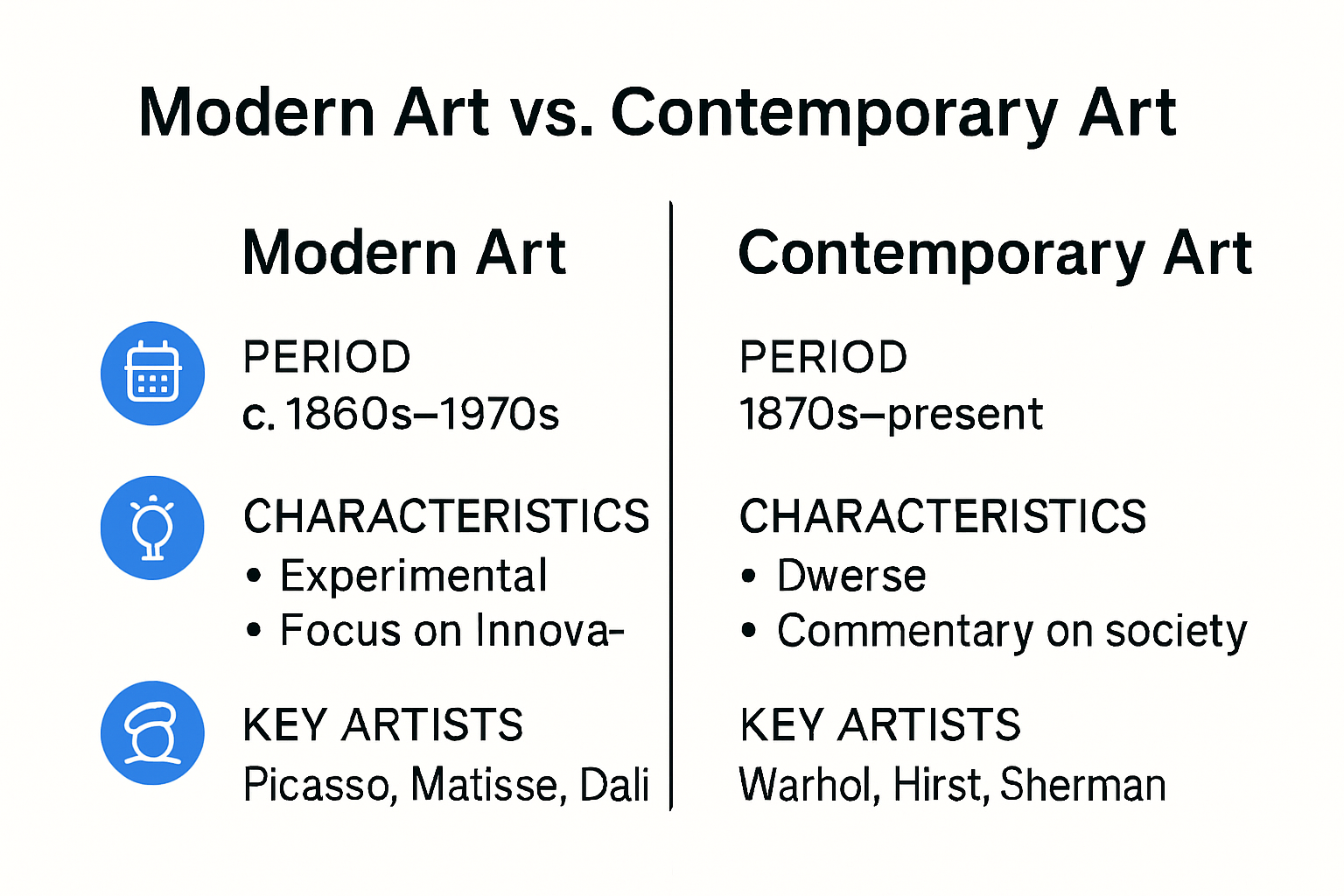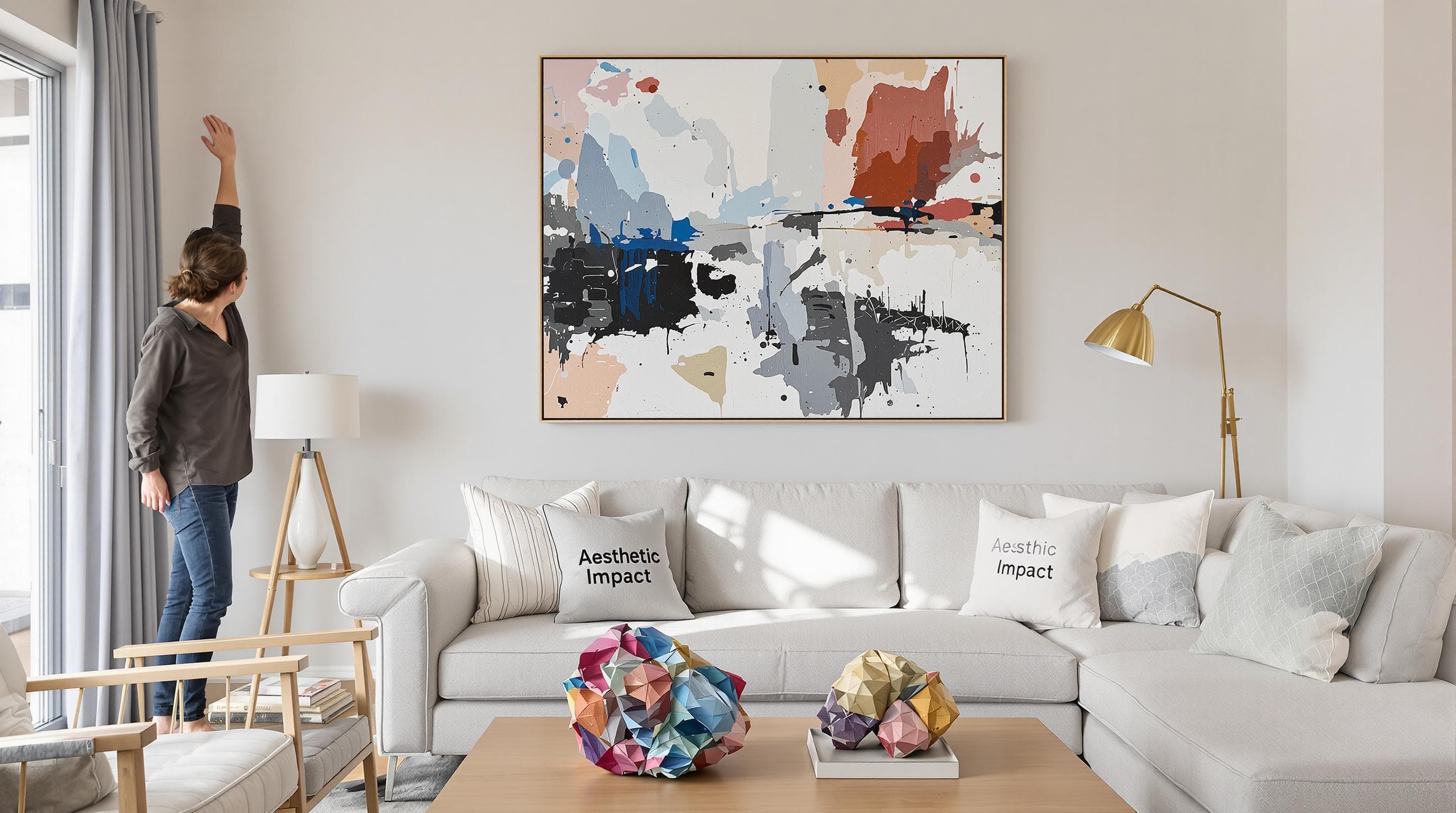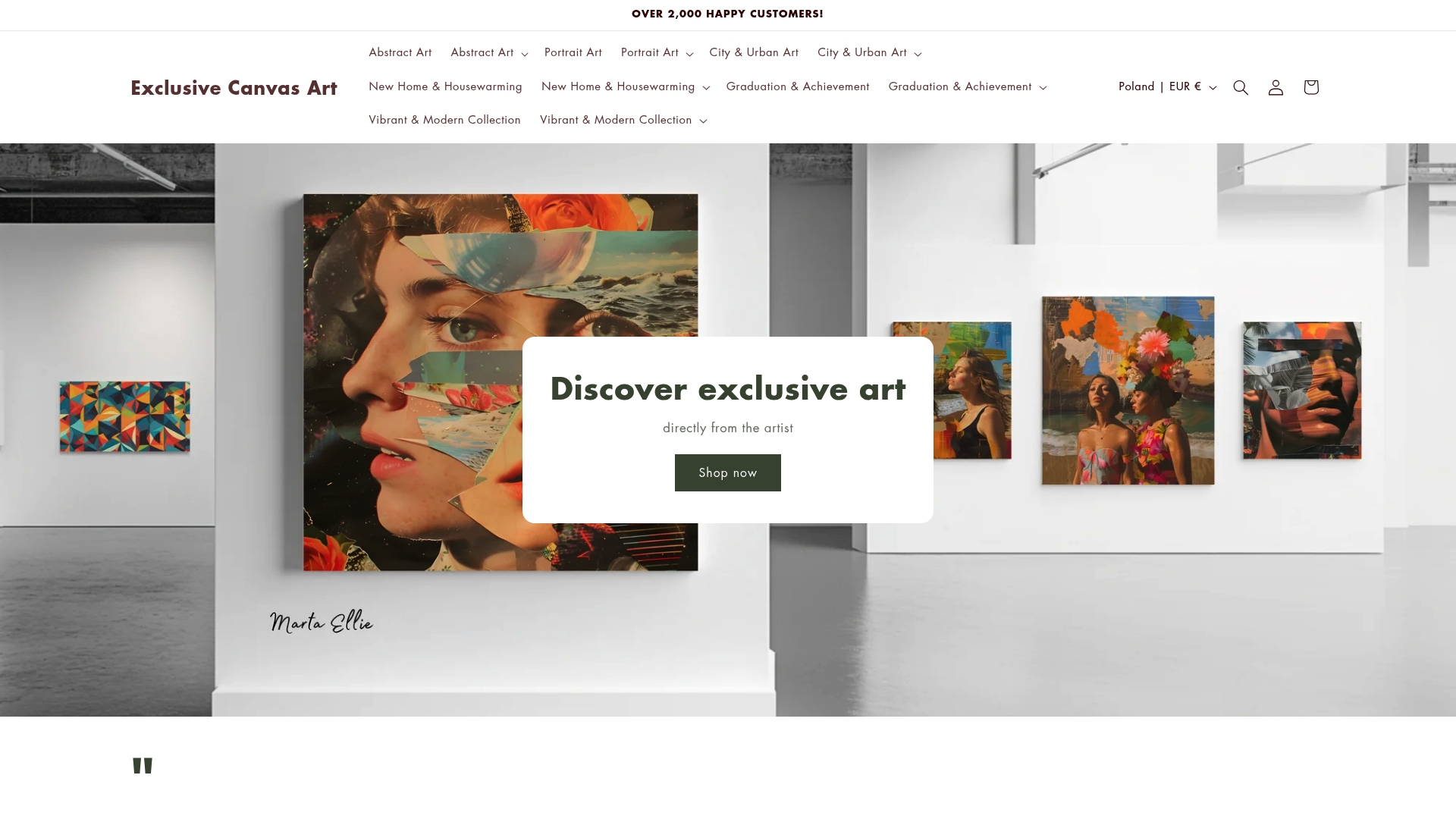
Contemporary vs Modern Art: Guide for Collectors & Decorators 2025

The world of art collections is more layered than most realize. Here is something many people miss. Contemporary art only started around the 1970s, while modern art actually goes back to the 1860s, spanning over a century of radical changes. This means that picking the right style for your home or collection is not just about colors or trends. It is about choosing which part of history and which vision of the future you want to live with every day.
Table of Contents
- Key Differences: Contemporary Vs Modern Art
- How Each Style Impacts Home Decor
- Choosing The Right Art For Your Space
- Top Tips For Collectors And Gift Buyers
Quick Summary
| Takeaway | Explanation |
|---|---|
| Understanding the Distinction | Contemporary art, emerging from the 1970s, is characterized by fluidity and interdisciplinary expressions, while modern art spans from the 1860s to the late 1960s and emphasizes innovation and abstraction. |
| Art’s Impact on Home Decor | Art not only enhances aesthetics but can also transform emotional experiences and spatial dynamics in a home. Modern art suits minimalist design, while contemporary art fits eclectic spaces. |
| Choosing the Right Piece | Selecting artwork should consider space compatibility, emotional resonance, and practical integration. Understand your personal connection to the art and how it interacts with your living environment. |
| Collector Insights | Building relationships in the art community is essential for collectors. Engaging with galleries and understanding an artist’s background can enhance informed choices and the overall value of art acquisitions. |
Key Differences: Contemporary vs Modern Art
Understanding the nuanced distinctions between contemporary and modern art requires a deep dive into their historical, philosophical, and aesthetic characteristics. While these terms are often used interchangeably, they represent distinct artistic periods and approaches that significantly impact how art collectors and decorators approach their selections.

Chronological Context and Historical Evolution
The timeline of art movements provides a critical foundation for distinguishing contemporary from modern art. Britannica clarifies that modern art spans from the 1860s to the late 1960s, encompassing revolutionary movements like Impressionism, Cubism, and Surrealism. These periods marked a radical departure from traditional artistic representations, challenging established norms and introducing groundbreaking techniques.
Contemporary art, by contrast, emerges from the 1970s onward, representing a more fluid and pluralistic approach to artistic expression. This era reflects the complex global landscape, incorporating diverse cultural perspectives and technological advancements. Artists working in contemporary styles often blur boundaries between different artistic disciplines, creating interdisciplinary works that challenge traditional categorizations.
Philosophical and Aesthetic Approaches
Fundación Mapfre highlights the philosophical distinctions between these artistic periods. Modern art primarily emphasized innovation, abstraction, and experimental forms. Artists like Picasso, Kandinsky, and Mondrian sought to deconstruct traditional visual representations, focusing on geometric shapes, bold colors, and conceptual interpretations of reality.
Contemporary art takes this experimental spirit further, expanding beyond aesthetic exploration to address complex social, political, and cultural narratives. Irish Museum of Modern Art notes that contemporary artists frequently use their work as a medium for commentary, challenging viewers to engage with critical global issues such as identity, technology, environmental concerns, and social justice.
Medium and Artistic Expression
The evolution of artistic mediums represents another crucial differentiator between modern and contemporary art. Modern artists predominantly worked with traditional mediums like oil painting, bronze sculpture, and printmaking. Their focus was on technical mastery and innovative representation within established artistic frameworks.
Contemporary artists, however, embrace a dramatically expanded artistic toolkit. Digital technologies, performance art, multimedia installations, and interactive experiences have become standard modes of expression. This shift reflects broader technological and cultural transformations, allowing artists to create immersive, boundary-pushing experiences that extend far beyond conventional canvas or sculpture formats.
For art collectors and decorators, understanding these distinctions becomes essential in curating meaningful spaces. Whether selecting a bold Cubist painting from the modern era or a provocative multimedia installation representing contemporary sensibilities, each choice communicates a distinct aesthetic and philosophical perspective. The key lies in recognizing that both modern and contemporary art offer unique windows into human creativity, cultural evolution, and artistic innovation.
–
To help readers quickly compare the characteristics of modern and contemporary art, the following table summarizes their main differences across history, approach, and medium.
| Aspect | Modern Art (1860s–late 1960s) | Contemporary Art (1970s–Present) |
|---|---|---|
| Historical Context | Emerged in industrial era; focused on progress and innovation | Emerged post-1970s; reflects a global, pluralistic society |
| Key Movements | Impressionism, Cubism, Surrealism | Postmodernism, Conceptual Art, Digital Art |
| Artistic Approach | Innovation, abstraction, experimentation | Social commentary, fluidity, interdisciplinarity |
| Philosophical Focus | Deconstructing tradition, formal aesthetics | Engaging with identity, technology, current issues |
| Mediums Used | Oil painting, sculpture, printmaking | Digital, installation, performance, multimedia |
| Visual Qualities | Geometric shapes, bold color, abstraction | Mixed media, interactive, evolving materials |
–
How Each Style Impacts Home Decor
The integration of art into home decor represents more than mere aesthetic embellishment. Art serves as a powerful design element that transforms living spaces, communicating personal narratives and creating emotional connections through visual expression. Modern and contemporary art styles offer distinct approaches to interior design, each bringing unique characteristics that can dramatically reshape a room’s atmosphere and perceived energy.
Spatial Dynamics and Aesthetic Principles
ResearchGate reveals that contemporary art trends have significantly transformed interior design approaches, creating innovative environments that blend artistic expression with functional design elements. Modern art tends to create structured, geometric spaces with clean lines and bold color statements. Paintings from this era often feature angular compositions that complement minimalist furniture, establishing visual rhythms that guide the viewer’s eye through the room.

Contemporary art, by contrast, introduces more fluid and unpredictable design elements. These artworks frequently challenge traditional spatial boundaries, incorporating mixed media installations, digital projections, and interactive pieces that blur lines between decorative object and functional space. This approach encourages dynamic interior configurations that adapt and evolve with changing personal aesthetics.
Emotional and Psychological Impact
The psychological influence of art selection extends far beyond visual appeal. Research on Interior Design Transformation indicates that art objects create unique object-spatial environments that profoundly affect inhabitants’ emotional experiences. Modern art pieces often evoke feelings of intellectual curiosity and structured contemplation. Think Mondrian’s geometric abstractions or Picasso’s analytical Cubist works that invite rational engagement and precise visual analysis.
Contemporary art pieces, however, tend to provoke more immediate emotional responses. These works frequently address complex social narratives, personal identities, and global perspectives. An installation exploring migration experiences or a multimedia piece confronting environmental challenges can transform a living space from a passive background into an active dialogue platform.
Practical Integration and Design Strategies
Practical considerations play a crucial role in successfully incorporating these artistic styles into home decor. Nostalgic Design Research suggests that design strategies are increasingly about creating dynamic, stimulating environments that reflect personal narratives. For those interested in diving deeper into art selection, our expert guide on choosing living room wall art offers comprehensive insights.
Modern art works best in spaces with neutral color palettes and minimal furniture, allowing geometric compositions and bold colors to become focal points. Contemporary art offers more flexibility, working beautifully in eclectic spaces that welcome mixed textures, unconventional materials, and provocative visual statements. The key lies in understanding that art is not just a decorative afterthought but a fundamental design element that shapes spatial perception and emotional experience.
–
To clarify how each art style can impact home decor, this table summarizes their preferred environments, typical effects, and practical considerations.
| Art Style | Best Fit Spaces | Typical Effect on Room | Integration Tips |
|---|---|---|---|
| Modern Art | Minimalist, neutral, structured | Creates order, intellectual focus | Use as visual anchor; limit other decor |
| Contemporary Art | Eclectic, dynamic, colorful | Adds energy, fosters dialogue | Mix textures/materials; allow for flexibility |
–
Choosing the Right Art for Your Space
Selecting the perfect art piece for your living space transcends mere decoration. It is a deeply personal journey of expressing individual identity, creating emotional resonance, and transforming empty walls into narrative landscapes that reflect your unique aesthetic sensibilities.
Understanding Space and Style Compatibility
Interior Plus highlights that contemporary interior design is fundamentally fluid, blending various styles, textures, and colors while incorporating innovative materials and technologies. When choosing art, consider how the piece interacts with your existing architectural elements, furniture, and color palette.
Modern art works best in spaces with clean lines and minimalist design. Geometric abstractions, bold color block paintings, and structured compositions complement spaces with sleek furniture and neutral backgrounds. These artworks create visual anchors that draw the eye and provide intellectual stimulation. Conversely, contemporary art thrives in more eclectic environments, offering versatility through mixed media, unconventional materials, and provocative visual narratives.
Emotional Resonance and Personal Connection
Reverie Art emphasizes that fine art establishes a profound sense of place, creating focal points that set emotional tones within living spaces. When selecting art, prioritize pieces that resonate with your personal experiences, aspirations, and emotional landscape.
Modern art often appeals to those who appreciate intellectual engagement. Cubist paintings or abstract expressionist works invite analytical contemplation, perfect for spaces dedicated to creativity and deep thinking. Contemporary art, with its broader narrative scope, suits individuals seeking emotional complexity. Multimedia installations or pieces addressing social themes can transform a room into a dynamic conversation starter.
Practical Selection Strategies
Practical considerations are crucial in art selection. Room size, lighting, and existing decor play significant roles in determining the most suitable artwork. Smaller spaces benefit from lighter, more minimalist pieces that create visual expansion, while larger rooms can accommodate bold, statement artworks that demand attention.
Color coordination remains essential. While exact color matching is unnecessary, artworks should complement or intentionally contrast with your room’s color scheme. Our comprehensive guide on selecting living room wall art offers nuanced insights into creating harmonious visual environments.
Budget considerations should not limit artistic expression. Emerging artists, limited edition prints, and diverse mediums offer affordable alternatives to expensive original pieces. The key is finding art that speaks to you personally, regardless of its market value.
Remember that art selection is an evolving process. Your taste will change, spaces will transform, and the artwork you choose today might tell a completely different story tomorrow. Embrace this dynamic relationship between art, space, and personal growth, allowing your living environment to become a true reflection of your inner world.
Top Tips for Collectors and Gift Buyers
Navigating the world of modern and contemporary art requires more than just aesthetic appreciation. For collectors and gift buyers, understanding the nuanced landscape of art acquisition involves strategic knowledge, careful research, and a genuine passion for artistic expression.
Developing Your Artistic Eye and Knowledge
Artsper recommends consistently educating yourself by visiting galleries, museums, and exhibitions. This practice helps develop a sophisticated understanding of artistic movements, techniques, and emerging trends. Regular exposure allows you to distinguish between decorative pieces and works with significant artistic merit.
For gift buyers, this means moving beyond impulse purchases. Consider the recipient’s personal style, existing decor, and emotional connection to art. Contemporary and modern art pieces are not just visual objects but narratives that communicate complex emotions and perspectives. Understanding an artwork’s context can transform a simple gift into a deeply meaningful experience.
Financial and Practical Considerations
Artwork Archive emphasizes the importance of establishing a comprehensive budget. This goes beyond the initial purchase price and includes additional expenses like professional framing, shipping, potential restoration, and insurance. Emerging collectors should allocate funds not just for acquisition but for the entire art ecosystem.
When selecting art as a gift, consider pieces that offer versatility. Limited edition prints, smaller canvas works, or pieces from emerging artists can provide affordable yet meaningful options. For unique gift selections that capture artistic essence, explore collections that blend aesthetic quality with personal significance.
Building Relationships and Making Informed Choices
Art Mine highlights the critical importance of building relationships within the art community. Engaging with galleries, attending artist talks, and connecting with curators can provide insights beyond what’s visible in the artwork. These connections offer opportunities to understand an artist’s journey, the conceptual depth of their work, and potential future value.
For collectors, this means looking beyond immediate visual appeal. Research the artist’s background, exhibition history, and critical reception. Contemporary art, in particular, often carries complex social or philosophical narratives that enhance its value beyond mere aesthetic qualities.
Gift buyers should approach art selection as a thoughtful process of storytelling. A well-chosen piece reflects not just artistic taste but an understanding of the recipient’s personal narrative. Whether it’s a modern geometric print for an architect friend or a provocative contemporary installation for a socially engaged colleague, the right artwork can communicate volumes.
Remember that art collecting is a journey of continuous learning and personal growth. Each piece you acquire or gift is an opportunity to explore human creativity, challenge perspectives, and create meaningful connections. The most valuable art transcends its physical form, becoming a bridge between personal experiences, cultural narratives, and shared human emotions.
Frequently Asked Questions
What is the main difference between contemporary and modern art?
Contemporary art refers to artworks created from the 1970s to the present, while modern art spans from the 1860s to the late 1960s. The two styles differ in their historical context and artistic approaches.
How does the choice between contemporary and modern art impact home decor?
Choosing between contemporary and modern art affects the overall aesthetics and emotional atmosphere of a space. Modern art typically suits minimalist designs, while contemporary art fits eclectic spaces, allowing for more expressive and dynamic integration.
What are effective tips for selecting the right art piece for my space?
Consider the compatibility of the artwork with your space, the emotional resonance it brings, and practical aspects like size and color. Aim for pieces that reflect your personal style and enhance the overall decor.
How can art collectors build relationships in the art community?
Collectors can build relationships by engaging with art galleries, attending exhibitions, and participating in artist talks. These connections help deepen understanding of artistic contexts and enhance informed choices in acquisitions.
Curate Your Signature Space With Museum-Quality Art
Are you struggling to decide between modern or contemporary art, fearing your home may not truly reflect your personality or story? This guide highlights how the right art transforms not only your décor but also your emotional connection to your environment. Whether you want bold, minimalist inspiration or a dynamic, conversation-starting piece, the choices you make today define the character and energy of your space. For those seeking sophisticated wall décor that makes a statement, the Office Art Collection - Wall Decor for Workspaces showcases exclusive canvas art inspired by both modern and contemporary styles.

Bring Marta Ellie’s uniquely crafted artworks into your home and experience a new level of personalization. Each piece is created with careful attention to historical context and artistic expression, mirroring the principles discussed in our article. Browse the collections on martaellie.com today and find artwork that resonates with your style and space. Elevate your surroundings with art that matches your taste and vision—now is the perfect moment to start your collection.
Recommended
- Contemporary Art Influences: Trends Designers Love in 2025 – Exclusive Canvas Art
- How to Choose Art for Living Room Walls: 2025 Guide – Exclusive Canvas Art
- Modern Art Themes for Bedrooms: Creative Ideas for 2025 – Exclusive Canvas Art
- Modern Art Themes for Every Room: Stylish Ideas for 2025 – Exclusive Canvas Art
- Storytelling Through Art: Wall Decor Ideas for 2025 Collectors – Exclusive Canvas Art
- Framing Art Prints Guide 2025: Expert Tips for Modern Decor – Exclusive Canvas Art